Key takeaways:
- Selective mutism is a complex anxiety disorder where children may speak freely in familiar settings but become silent in others, reflecting deep internal battles.
- Silence can serve as a protective mechanism, allowing for reflection and deeper connections, and it is essential for mental well-being.
- Embracing silence can enhance self-discovery, creativity, and provide a sense of belonging, transforming experiences of isolation into opportunities for growth.
- Creating a supportive environment involves active listening, non-verbal communication cues, and normalizing moments of quiet to foster deeper connections.
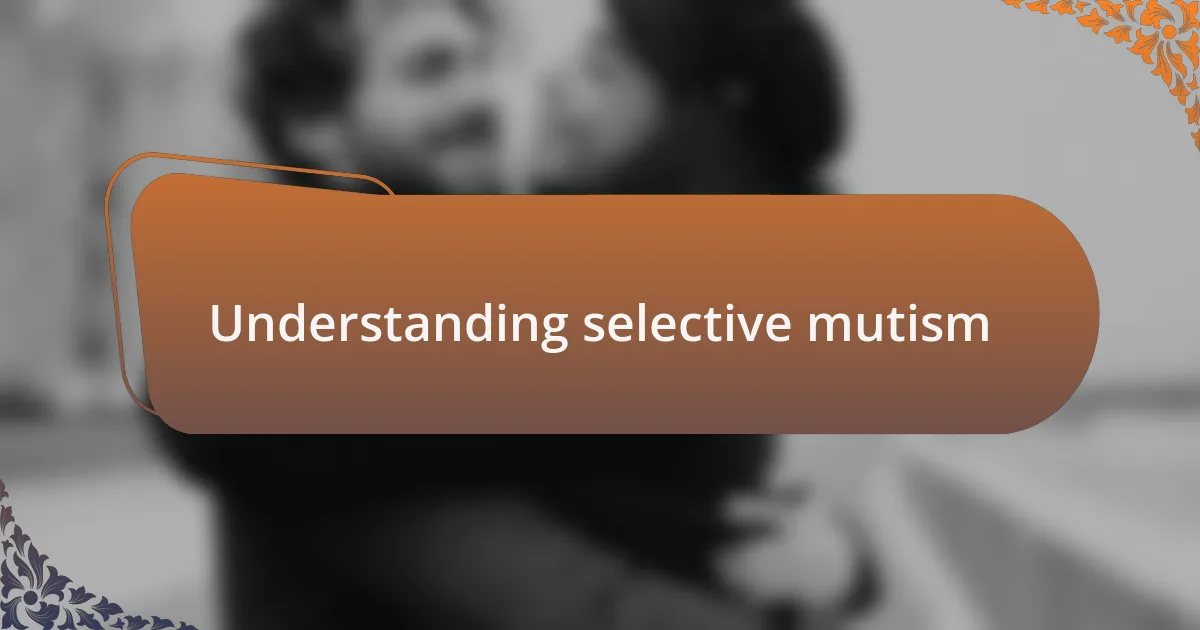
Understanding selective mutism
Selective mutism is a complex childhood anxiety disorder where a child may be completely silent in certain social situations while speaking freely in others, often around family. I remember a friend whose son would light up at home, chatting away, but clam up completely at school. It made me wonder, what kind of fear must he have been grappling with to feel so trapped in a space meant for learning and exploration?
This condition is often misunderstood; many people assume it’s merely shyness. But from my observations, there’s so much more beneath the surface. For children, the pressure to speak can be incredibly overwhelming. Can you imagine feeling like your voice simply won’t cooperate when you need it most? In my experience, such internal battles lead to a profound sense of isolation and frustration.
Understanding selective mutism requires empathy and patience. Each child’s experience is unique, shaped by their environment and personal history. I’ve seen parents face the challenge head-on, embracing their child’s silence as a valid form of communication. How powerful is that? Instead of rushing to fix the silence, they create an atmosphere of support, letting the child know that their feelings are acknowledged.
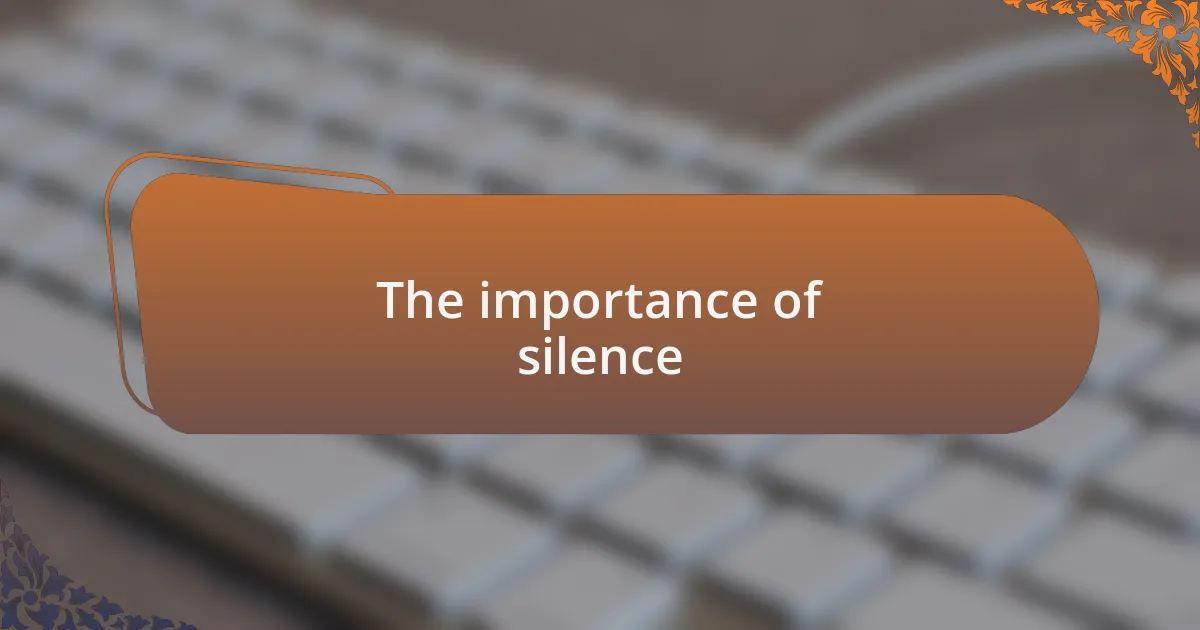
The importance of silence
Silence can often serve as a protective shield for those grappling with anxiety. I recall a time when I sat in a quiet room, feeling the weight of unspoken words. In that moment, I realized how crucial silence can be; it’s not just the absence of sound, but a space for reflection and self-discovery. Have you ever found comfort in silence, feeling it wrap around you like a warm blanket?
Embracing moments of silence allows for deeper understanding, both of ourselves and others. I once listened intently to a friend who struggled to express herself verbally. Just by being present in silence, I could feel her emotions flooding the room. It dawned on me that sometimes, it’s in these quiet interactions where true connection thrives. Isn’t it fascinating how silence can speak volumes?
Moreover, I’ve learned that silence offers a remedy in fast-paced environments. During a particularly stressful period, I chose to step away from the noise—to meditate and simply breathe. Those brief intervals of stillness brought clarity and reassurance, reminding me that it’s okay to pause. How often do we neglect this essential practice, thinking we must always be engaged?
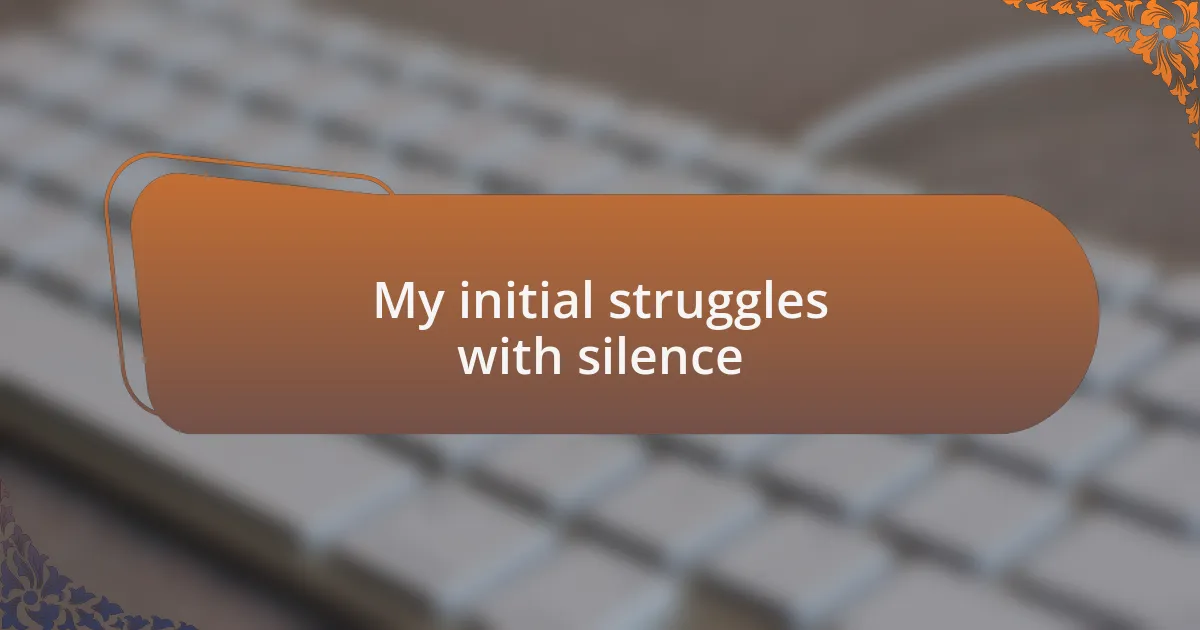
My initial struggles with silence
At first, silence felt like a daunting void rather than a comforting retreat. I remember sitting in a classroom, my heart racing when my teacher asked for volunteers. The pressure to speak loomed over me; every moment of quiet seemed to amplify the noise in my head, filling me with self-doubt. Have you ever experienced that heavy silence, where the tension between you and the world felt almost unbearable?
As I began to navigate my journey with silence, I often found myself grappling with an overwhelming sense of isolation. In social settings, I felt trapped between wanting to engage and fearing judgment. I can vividly recall a family gathering where laughter and chatter surrounded me, but I remained silent, feeling like an invisible observer. Isn’t it ironic how silence can sometimes highlight loneliness, even in a crowded room?
Over time, these struggles gradually morphed into opportunities for growth. One day, I decided to take a solitary walk in the park, immersing myself in the sounds of nature. The chirping birds and rustling leaves offered a different kind of conversation—one that didn’t require words. In that moment, I discovered that silence could also bring a sense of belonging, a reminder that I could be part of the world without uttering a single word. Isn’t it fascinating how silence can transform our experience?
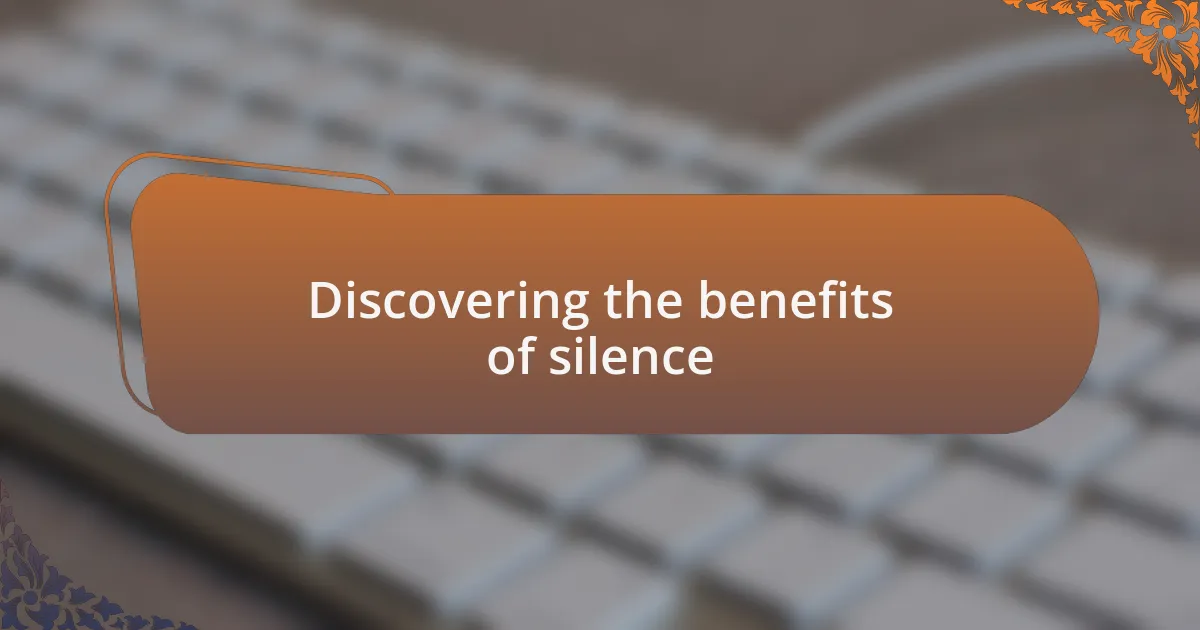
Discovering the benefits of silence
Finding the benefits of silence was a revelation for me. In quiet moments, I began to listen—not just to the world around me, but to my inner thoughts and feelings. It struck me that without the distractions of conversation, I could reflect more deeply on my experiences and emotions. Has anyone else discovered that clarity often emerges when we pause and just listen?
One afternoon, I experimented with a simple practice: I turned off all distractions and just sat in silence for ten minutes. It felt painfully long at first, but as I let go of my expectations, I noticed how my breathing slowed and my mind began to calm. In that stillness, I found space to nurture my creativity, allowing ideas to flow without the interference of self-criticism. How liberating it was to realize that silence could foster creativity instead of stifling it!
As I embraced longer periods of silence, I started to appreciate its impact on my well-being. I remember a weekend retreat where I spent hours in silence amidst nature. Every sound—birds chirping, leaves rustling—became amplified, creating a beautiful symphony that comforted my soul. In that serene space, I felt a profound connection with myself and the world, a stark contrast to the noise of daily life. Have you ever felt that gentle pull of peace when silence envelops you?
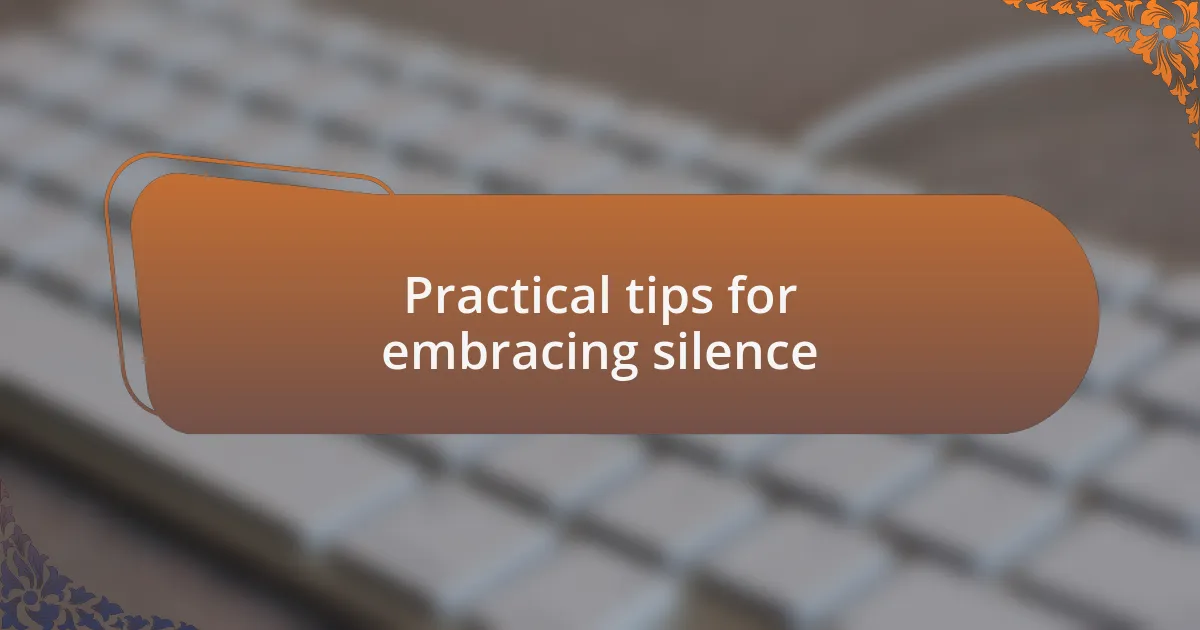
Practical tips for embracing silence
Finding practical ways to embrace silence can seem daunting at first, but I’ve discovered a few techniques that truly resonate with me. One approach is to create a dedicated quiet space in your home. I transformed a corner of my living room into an inviting nook with comfy cushions and soothing lighting. This became my go-to spot for reflection, where I could unwind with my thoughts without the chaos of daily life intruding. What simple changes to your environment could encourage you to seek out silence?
Another tip I’ve found beneficial is to incorporate silence into routine activities. I began taking short, silent walks during my lunch breaks. At first, it felt strange to walk without my usual podcasts or music. However, over time, I learned to appreciate the rhythm of my footsteps and the subtle sounds of nature around me. Have you ever noticed how refreshing it feels to engage with the world, even in silence, while taking a simple stroll?
Finally, practicing mindfulness meditation opened up a new dimension of silence for me. I started with guided sessions, but gradually moved to sitting in silence for ten minutes each day. As I sat there and focused on my breathing, I was often surprised by what arose in my mind—emotions, memories, and sometimes even a sense of gratitude. It’s remarkable how embracing silence can lead to deeper self-discovery. What insights could you uncover if you gave yourself the gift of stillness?
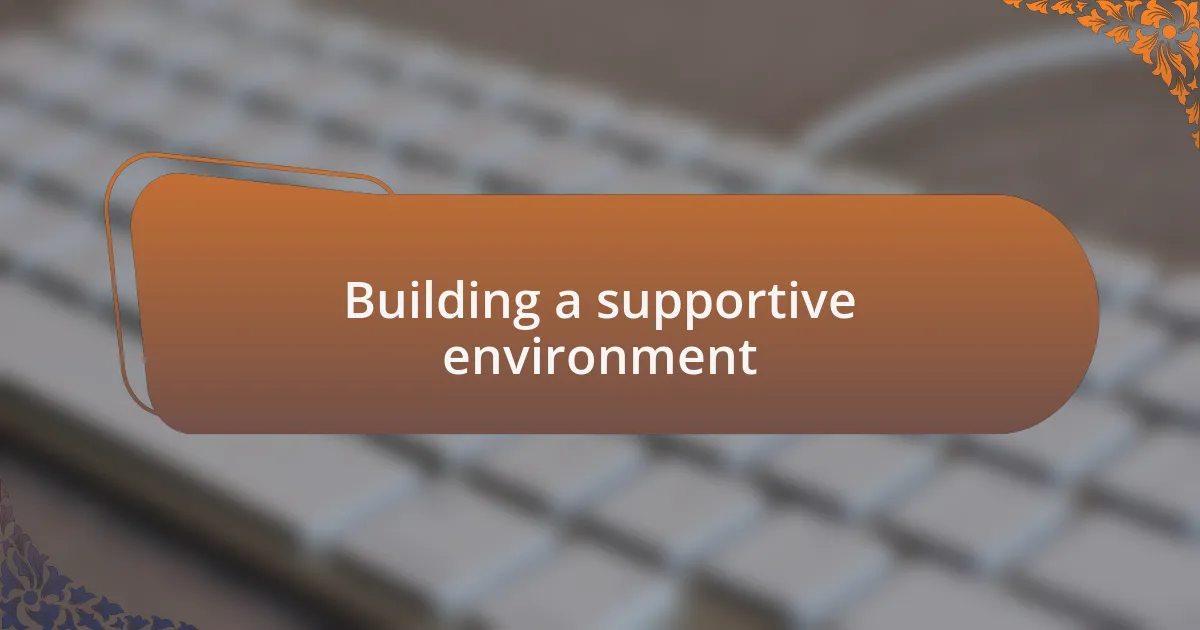
Building a supportive environment
Building a supportive environment starts with active listening. When people around you make an effort to truly hear each other, it sets the tone for openness and acceptance. I recall a friend who always paused to give me her full attention, which made me feel valued and understood, allowing me to share more in moments of silence.
Additionally, creating non-verbal communication cues can be extremely helpful. I remember using hand signals with my family during silent moments, which made it feel easier to express thoughts without the pressure to talk. What simple gestures could foster deeper connections for you?
Another key element is offering reassurance without pushing for dialogue. I once attended a gathering where the host encouraged everyone to relish moments of quiet without pressure to fill them with chatter. Seeing others embrace silence together gave me the courage to join in. How can you embrace and normalize such moments in your own life?
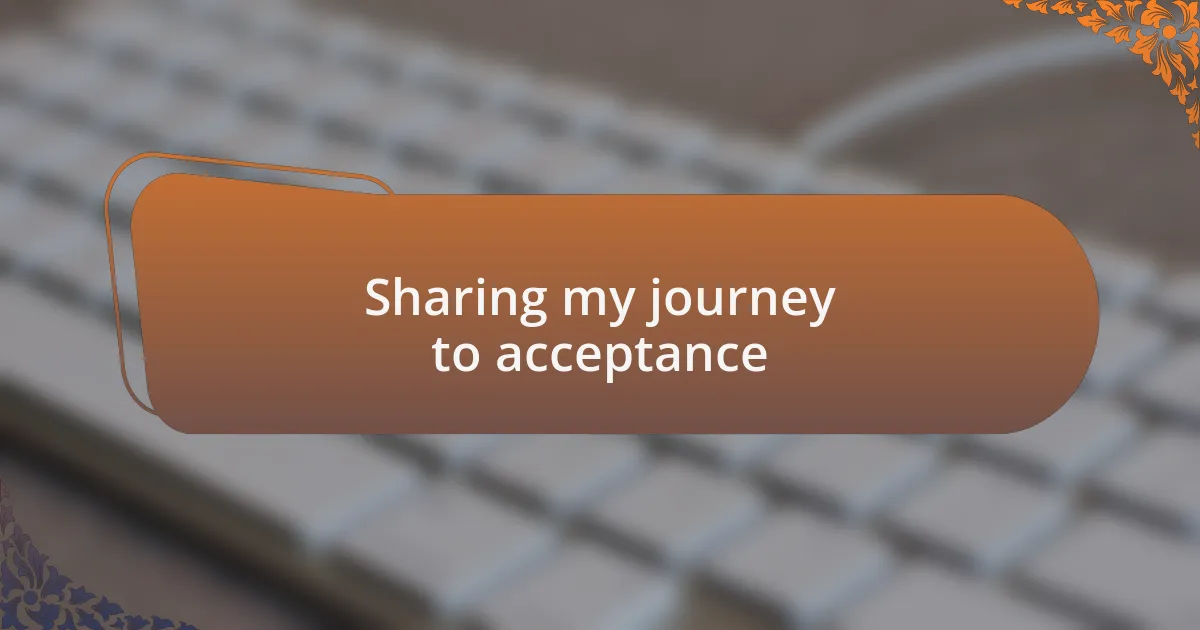
Sharing my journey to acceptance
Embracing silence was not an overnight journey for me; it took time and self-reflection. I vividly remember the day I realized that my quietness didn’t equate to weakness. I sat in a coffee shop, surrounded by chatter, yet felt at peace within my own thoughts. It struck me then—acceptance begins with understanding that my silence holds value.
There were moments when I felt overwhelmed by the expectation to speak. A close family member once shared a heartfelt story about their struggles with anxiety, and it opened a pathway for me to express my own experiences without fear of judgment. This shared vulnerability made me appreciate that acceptance doesn’t always require words; sometimes, just being present is enough. Have you ever found empowerment in simply listening rather than reacting?
Through this journey, I discovered the power of patience, both with myself and others. After a particularly challenging day, I took time to sit in silence, reflecting on how far I had come. It was during those quiet moments that I truly accepted my journey—recognizing silence as a powerful form of communication. Have you found your own moments of clarity in the stillness?